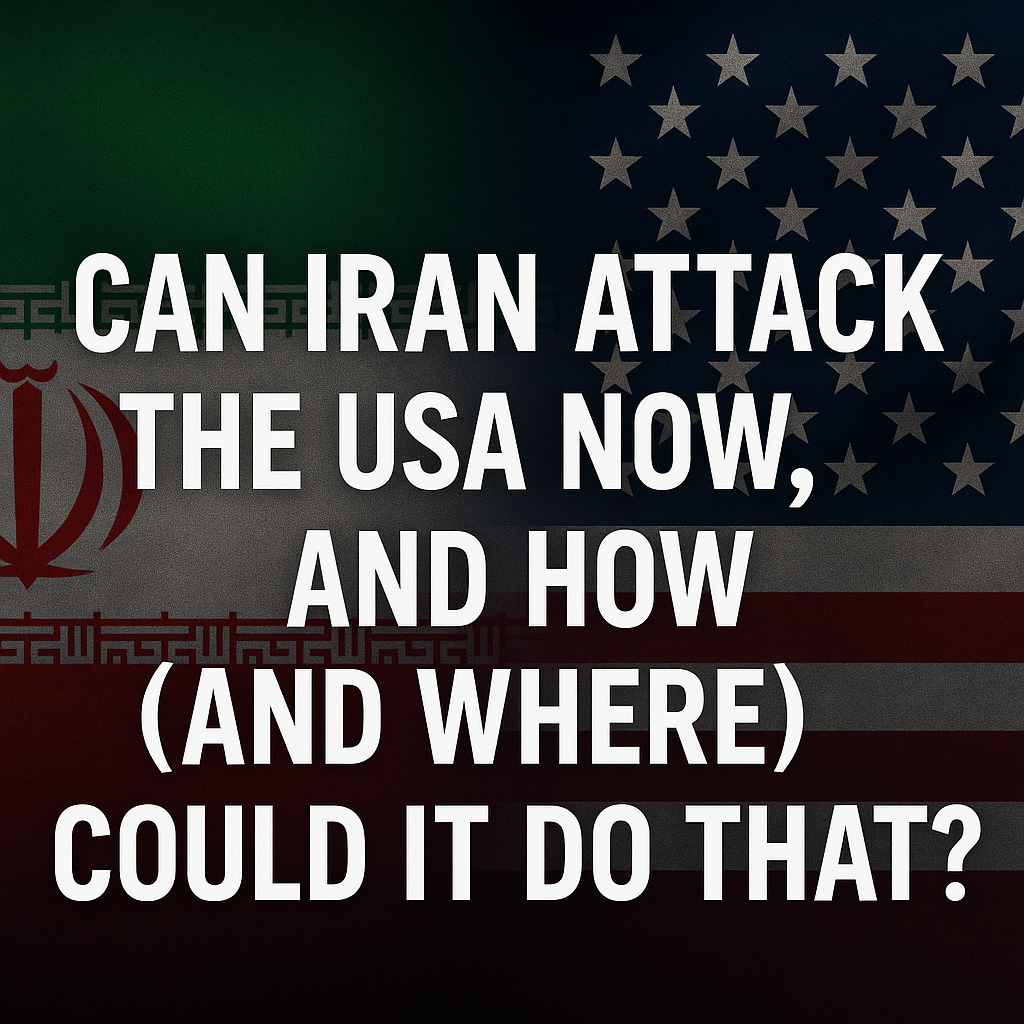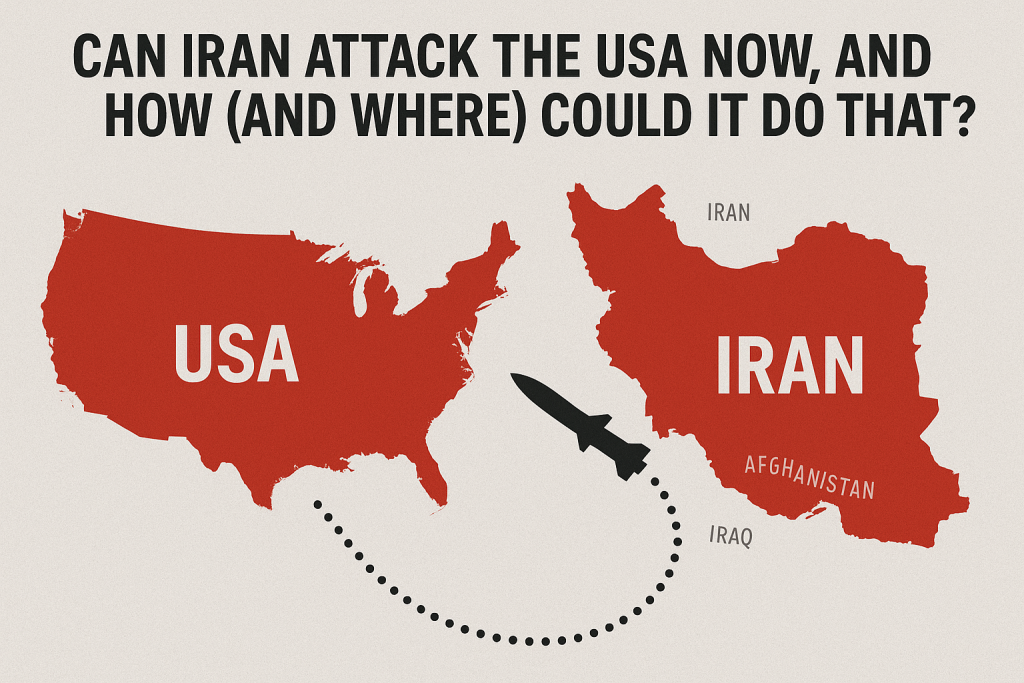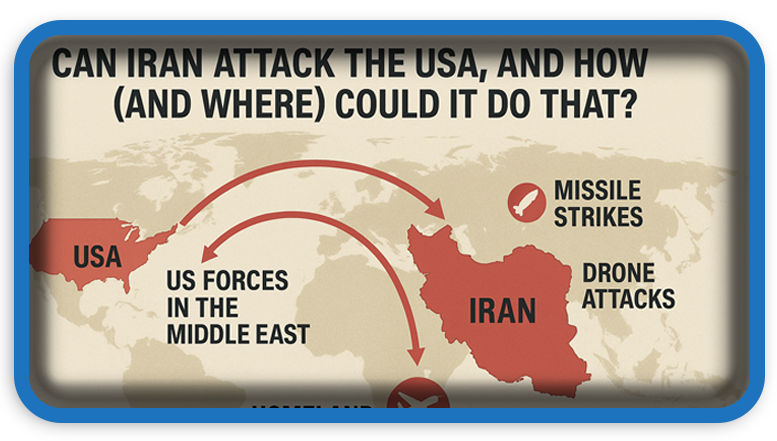⏲️ Estimated reading time: 7 min
Can Iran Attack the USA Now, and How (and Where) Could It Do That? Can Iran strike the United States? Not directly but through proxies, missiles, cyberwarfare, and asymmetric tactics, it can still do significant damage. This post explores the geopolitical realities, military capabilities, and vulnerable zones in this high-stakes confrontation.
🛡️ Can Iran Attack the U.S. Mainland?
Let’s get the short answer out of the way: Iran cannot currently launch a direct, large-scale attack on the continental United States.
Unlike countries with advanced intercontinental ballistic missile (ICBM) systems such as Russia or China Iran’s missile technology does not allow it to reach targets thousands of kilometers away across the Atlantic or Pacific.
🔍 Current Capabilities
Iran possesses:
- Short-range and medium-range ballistic missiles (SRBMs/MRBMs).
- A large Revolutionary Guard Corps (IRGC) and Quds Force, trained in unconventional tactics.
- Drones (UAVs), some of which have demonstrated regional range and precision.
- A growing cyberwarfare division.
However, none of these assets can currently project conventional force directly onto U.S. soil. The United States mainland remains outside of Iran’s kinetic strike range.
⚔️ How Could Iran Strike Indirectly?
Though a full-scale war with the U.S. is unwinnable for Iran, it has long excelled at asymmetric warfare unconventional strategies that create strategic pain without direct confrontation. Here are the main ways Iran could retaliate or apply pressure:

1. Missile Strikes on U.S. Bases in the Middle East
Iran’s most immediate method of retaliation lies in its missile arsenal, especially in response to perceived U.S. aggression. Iran has demonstrated its ability to target:
- Al Asad Airbase in Iraq (2020) Following the U.S. killing of General Qassem Soleimani, Iran launched a dozen ballistic missiles targeting U.S. forces in Iraq. Though no fatalities occurred, it marked the first overt missile attack by Iran on U.S. troops.
Targets Within Missile Range:
| Country | Key U.S. Military Assets |
|---|---|
| Iraq | Al Asad, Erbil Airbase |
| Qatar | Al Udeid Air Base |
| Kuwait | Camp Arifjan |
| Bahrain | U.S. Fifth Fleet (Naval Command) |
| UAE | Al Dhafra Air Base |
| Syria | U.S. outposts near oil-rich regions |
Iran’s missiles particularly the Fateh-110, Shahab-3, and Sejjil series have ranges between 300 km and 2000 km. That makes U.S. military installations across the Middle East vulnerable to precision or saturation attacks.
2. Proxy Attacks via Militias and Allied Forces
Iran does not need to act alone. It exerts massive influence over regional militias and insurgent groups, using them as proxies to destabilize enemies.
Key Proxy Forces:
- Hezbollah (Lebanon) – A heavily armed and Iran-backed militia capable of launching thousands of rockets into Israel.
- Houthis (Yemen) – Responsible for missile and drone attacks on Saudi oil facilities and Red Sea shipping.
- Popular Mobilization Forces (Iraq) – Includes multiple militias loyal to Tehran.
- Syrian Militias – Some factions under Iranian influence operate near U.S. forces in eastern Syria.
Potential Attack Methods:
- Rocket fire on U.S. bases and embassies.
- Drone swarms attacking fuel depots or infrastructure.
- Cross-border raids on Israeli territory.
- Naval drones or mines targeting commercial or naval vessels.
The advantage for Iran? Plausible deniability. Proxy attacks muddy the lines of responsibility and reduce the risk of direct war.
3. Cyber Operations Against the United States
While Iran cannot bomb U.S. cities, it can hack them.
Capabilities:
- Cyber units embedded in the IRGC.
- Suspected attacks on banking systems, water infrastructure, and power grids.
- Use of ransomware or data wiping malware (e.g., “Shamoon” used against Saudi Aramco).
Real-World Example:
- 2012-2013: Iranian hackers were accused of launching DDoS attacks against U.S. banks, disrupting service to millions of customers.
- 2020: Officials alleged that Iran targeted U.S. voter databases and attempted to influence public opinion through fake emails.
Cyberwarfare offers Iran an arena where distance, geography, and military imbalance don’t matter. It’s fast, deniable, and often devastating.
4. Terrorist and Intelligence Operations Abroad
Iran’s Quds Force has a long history of organizing targeted assassinations, embassy attacks, and logistics sabotage.
Vulnerable Targets:
- U.S. embassies and consulates.
- Contractors working in conflict zones.
- Western tourists or journalists in high-risk regions.
Lone-wolf operations, supported ideologically or financially by Iran, also pose a risk in Europe and possibly the U.S., especially if geopolitical tensions escalate.
5. Maritime Disruption and Oil Route Tactics
The Strait of Hormuz is one of the most critical chokepoints in global energy logistics. Roughly 20% of the world’s oil passes through this narrow waterway.
Iran’s Tactics:
- Seizing tankers (e.g., 2019 incidents involving UK and UAE vessels).
- Mining the strait with hidden naval devices.
- Deploying fast attack boats to harass Western naval vessels.
- Firing anti-ship missiles from coastal batteries or islands like Abu Musa.
Even temporary disruptions in this region could spike global oil prices and trigger international panic without firing a shot at the U.S. mainland.
🎯 Where Is the U.S. Most Vulnerable to Iran?
| Region | Threat Level | Potential Iranian Strategy |
|---|---|---|
| Iraq | 🔥🔥🔥 | Rocket attacks on U.S. military installations |
| Syria | 🔥🔥 | Iranian militia activity near U.S. bases |
| Gulf | 🔥🔥 | Missile strikes or drone attacks on airbases |
| Israel | 🔥🔥🔥 | Hezbollah launches coordinated assaults |
| Red Sea | 🔥🔥 | Houthi threats to naval/commercial vessels |
| Cyberspace | 🔥🔥🔥 | Attacks on U.S. banks, utilities, transport |
🇺🇸 Would the United States Retaliate?
Almost certainly. U.S. policy has historically included immediate and overwhelming responses to attacks on its personnel or assets.
Likely U.S. Responses:
- Airstrikes on Iranian missile launch sites, radar stations, or nuclear facilities.
- Naval blockades and interdictions to pressure Iranian shipping.
- Cyber counterattacks designed to disable Iranian infrastructure.
- Assassinations or targeted drone strikes on Iranian military leaders.
While Washington may seek to avoid a ground war, escalation in response to Iranian aggression is always on the table.
🌐 Could Iran Target the U.S. Homeland in the Future?
Iran is reportedly working on missile technology with extended range, though progress is slow.
Key risks include:
- Smuggling weapons into the Western Hemisphere via third-party nations.
- Developing or acquiring hypersonic weapons from allies like North Korea.
- Recruiting operatives to carry out domestic sabotage.
While still highly speculative, security analysts warn of future threats evolving, especially if Iran continues building alliances with China, Russia, or Venezuela.

🤝 Is There a Diplomatic Off-Ramp?
Amid all the threats and warnings, diplomacy still plays a role.
Despite tensions, backchannel negotiations have occurred over:
- Nuclear enrichment limits.
- Sanction relief in exchange for behavioral changes.
- Regional de-escalation frameworks.
However, trust between the two countries is extremely low, and domestic politics in both nations make long-term diplomatic solutions fragile.
📌 Summary Table – Iran’s Attack Methods and U.S. Risk Assessment
| Method | Feasibility | Threat to U.S. Forces | Threat to Homeland |
|---|---|---|---|
| Missile Attacks (Middle East) | ✅ High | 🔥🔥🔥 | ❌ None |
| Proxy Warfare | ✅ Very High | 🔥🔥🔥 | ❌ Limited |
| Cyber Attacks | ✅ High | 🔥🔥 | 🔥🔥🔥 |
| Terror Operations Abroad | ✅ Medium | 🔥🔥 | 🔥 (low-level) |
| Maritime Choke Points | ✅ High | 🔥🔥🔥 | ❌ None |
🔍 Strategic Outlook
Iran is unlikely to start a direct war with the United States doing so would be militarily suicidal. Instead, it will continue its proven playbook: applying pressure through militias, regional chaos, cyber aggression, and diplomacy when needed.
The U.S., meanwhile, must balance deterrence with diplomacy, safeguarding allies while avoiding missteps that could lead to uncontrollable escalation.
🧭 Strategic Reality – War Without War
What we’re witnessing is a cold war-style conflict, where “war” happens through cyber cables, drones, sabotage, and shadow operatives, not armies and tanks.
In this reality, Iran’s goals are:
- Survival of the regime.
- Expulsion of U.S. influence from the region.
- Retaliation for perceived injustices (e.g., Soleimani’s death, sanctions).
- Regional dominance through proxies and strategic depth.
The U.S. must navigate this minefield carefully. One miscalculation could spark not a third world war but a regional inferno with global consequences.
🔔For more tutorials like this, consider subscribing to our blog.
📩 Do you have questions or suggestions? Leave a comment or contact us!
🏷️ Tags: Iran, USA, Military Strategy, Middle East Conflict, Cyberwarfare, Asymmetric Warfare, Missile Defense, Proxy War, Geopolitics, National Security
📢 Hashtags: #IranConflict, #USMilitary, #MiddleEastTensions, #CyberThreats, #Geopolitics, #AsymmetricWarfare, #MissileThreat, #ProxyWar, #StraitOfHormuz, #NationalSecurity
🧩 Global Flashpoint: What You Need to Know
Iran may not attack U.S. cities with missiles anytime soon, but it doesn’t need to. Asymmetric warfare is cheaper, sneakier, and often more effective. The battle for influence and deterrence is happening right now, in servers, on the seas, and across deserts. Stay informed.
Only logged-in users can submit reports.
Discover more from HelpZone
Subscribe to get the latest posts sent to your email.

